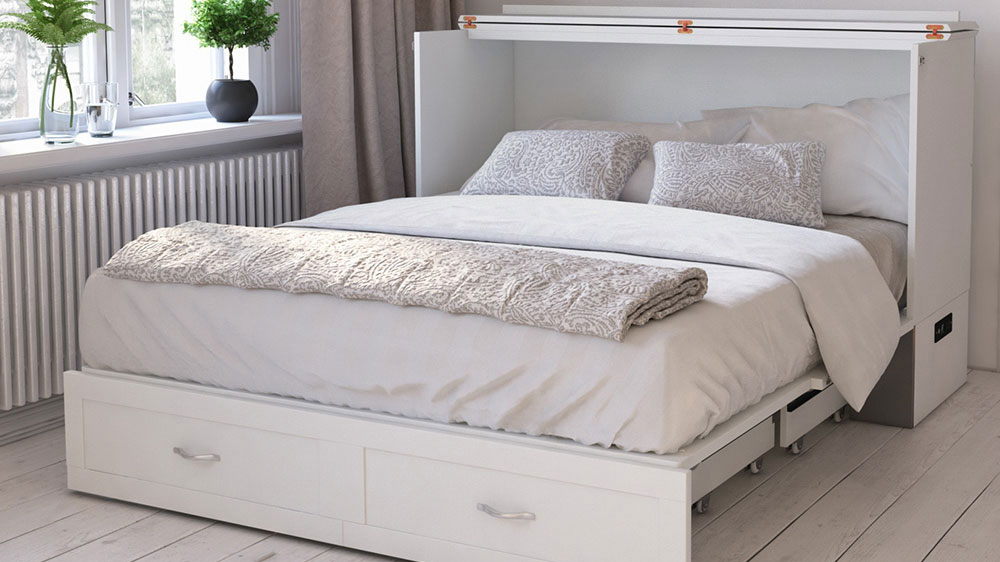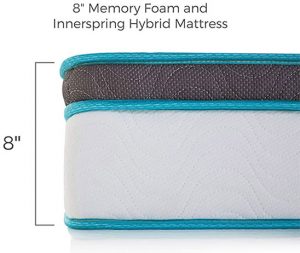
The Murphy Bed (otherwise known as a wall, pull-down or fold-down bed) is a bed that is hinged off a wall surface on one end so it can be stored vertically within a room. The bed is named after William Lawrence Murphy who gained the first patents around the year of 1900. The story goes that, “he was wooing an opera singer, but living in a one-room apartment in San Francisco, and the moral code of the time frowned upon a woman entering a man’s bedroom”, and hence the fold-down bed was invented!
These beds may seem like something of the past! But they are actually extremely versatile space-saving guest bed options. (Plus – they don’t all look like something from your grandparents’ house!)
Should you not wish to dedicate an entire room to be a guest room, or you need a multitasking space, Murphy beds are great! We’ve specified several Murphy beds for families who needed multifunctioning spaces. Within a few moments, a home office can be turned into a guest room. You may not want a full normal bed in this room if you don’t have guests often but you work 5 days a week. The great thing is, with a Murphy bed you will have the option to still have guests stay if you need to.
Let’s take a closer look at these beds in more detail.

A stylish example of a Murphy bed in action! The fold-down style is one of the most popular, particularly for multi-use rooms such as a Study or Playroom.
Who are the Murphy Beds for?
Murphy beds are fantastic temporary sleeping accommodations. Murphy beds are best for guest sleeping accommodations and typically found in home offices, craft rooms, hobby rooms, and even living rooms when space is at a premium. Murphy beds give homeowners the flexibility they need to accommodate guests while minimizing the dedicated square footage that a stationary guest bed takes up.
I have designed several home offices with Murphy beds integrated so that there was more space to access the desk and bookshelves when guests weren’t using the room. While the floor space still needs to be reasonably clear, this was a great solution for homeowners who didn’t want their office to feel claustrophobic and still have a place for guests to sleep.
Murphy beds are designed for short term use and not designed for daily use. A Murphy bed should be considered for guest sleeping and not for a full-time resident. They shouldn’t be used in homes with the elderly. As we age, bone density naturally degrades, and operating the mechanism becomes a safety hazard for older individuals.
Furniture that’s located in the same room as the Murphy bed should be easy to move if it’s in the way of the Murphy bed fully extending.
As designs move forward and become more advanced, there are some Murphy beds available that look like sideboard cabinets or trunks. These then extend and fold-out, but from a much lower position, so the operating mechanism isn’t as harsh or heavy as a full height fold-down Murphy bed.

Murphy Beds are now becoming more popular as design advances. This trunk-style Murphy bed is perfect for those who don’t want a large vertical unit and are limited on space. It adds character and a practical edge to a multi-purpose Living Room, Study or Guest Room.

This Murphy bed example shows a trunk / sideboard style fold-out bed which helps to minimize the amount of space needed when it’s not in use. A style like this allows a Murphy bed to blend easily into spaces.
The example above shows a sideboard cabinet style option that looks like a trunk which would add character to any spare room, while not taking up much space at all!
How to Allow Space for a Murphy Bed
Allowing enough space for a Murphy bed – and the surrounding area – is essential to get right. My clients are always surprised when I explain how deep the bed kit is when the bed is folded up against the wall. They are usually deeper than a standard bookshelf and when the bed is extended, it takes up about six more inches than if there was a mattress against the wall because the mechanism and framing are still in position.
Murphy beds are great for space-saving, but you should always make sure that someone can move freely throughout the room when the bed is extended out. I recommend at least three feet of clearance around two sides of the bed (the main walkway and foot of the bed) and at least eighteen inches between the bed and a wall (if not the main walkway).
These are the minimum clearances required when planning a bedroom and will ensure that your guests can move safely throughout the space, especially if they need to get up in the middle of the night and have limited lighting.
If space really is a premium, there are simple options available, like this:

Simplistic designs are readily available and can be installed in any room without taking up too much wall space. This design is great for space-saving.
Which can be neatly installed in almost any room of the home. To fold down for guests like this:

The simple design shown previously folds down into this stylish guest bed. If space is a premium, this is a fantastic solution.
Installing a Murphy Bed
Most Murphy beds have a bed kit available to install the bed directly to the wall without opening up the drywall. It’s critically important that the bed is secured to the studs in the wall or that blocking is added if installing against a masonry or concrete wall.
Bed kits include horizontal braces that provide great flexibility for installation so that the screws can be mounted through the brace and into the studs in the wall. Some bed kits have a notch in the bottom rear of the bed kit which accommodates a baseboard. If your bed kit includes this notch, then make sure that your baseboard isn’t taller than the notch or you’ll need to remove it.
Other bed kits are completely flush on the backside and require the homeowner or contractor to remove the portion of the baseboard that would fall behind the bed kit. It’s important to follow these instructions so that the case is completely flush to the wall and attached securely to avoid tipping.
Additionally, the wall needs to be flat without additional trims and moldings where the bed will be placed and should be free of obstructions such as wall vents, light switches, sconces, thermostats, or other home control systems.
If you have any concerns about the installation of your Murphy bed, contact your local representative, contractor, or designer and they will be able to advise you on the best course of action.
Alternatively, there are many storage cabinet options for a Murphy bed so they don’t necessarily need to be completely vertical up the wall if this is something that concerns you. Something like this:

This is another sideboard style Murphy bed which is perfect because of its modern design and simplicity. It looks just like any set of cupboards you might find in a Study or Guest Bedroom.
Can then fold out into this:

The fold-out of this cabinet style is really clean and sleek – providing good temporary accommodation for your guests. This Murphy bed even comes with the mattress included!
This also comes with a mattress as well, making it extremely cost-effective. The cabinet itself, when not used as a bed, looks great in any room. The great thing is that this option can still provide you with extra sleeping space when needed.
Choosing the Right Mattress

Typically, an 8-12inch thick mattress will work with a Murphy bed – but always remember to check the specifications on the Murphy bed frame/cabinetry before ordering! We love this mattress because it has an added layer of memory foam to provide a comfortable rest for guests.
Mattress selections are more limited for Murphy beds compared to standard beds, due to the depth. They are usually sold separately. That being said, Murphy bed manufacturers will provide specifications regarding the maximum depth of the mattress. The mattress depth is dictated by how deep the case of the Murphy bed is when the bed is folded up against the wall.
Mattress depths are typically shorter than what you’d purchase for your main bed and can sometimes be difficult to find. I recommend visiting a mattress store to test out mattresses and try to find the most comfortable mattress that also meets the depth requirements for the bed you select. Depending on other beds in your home, you may also need to purchase sheets specifically to fit this mattress and not be able to use a spare sheet set you have around the house.
Typically, mattresses that are 8-12 inches thick can work with a Murphy bed frame (if it doesn’t come with a mattress).
Something similar to the mattress shown above will work great. But always remember to check the product specifications of your Murphy bed before ordering a mattress.
Other Aspects to Consider
The front of a Murphy bed kit can be really beautiful and easily disguised as a built-in or storage cabinet. When planning to install a Murphy bed, it is also important to consider where the bedding and pillows will be stored. Sheets may be able to be on a bed itself that is folded, however bulkier items such as blankets and pillows will need to be stored separately so the bed can fold up. We usually suggest storing bulky items in a nearby closet, decorative basket, or decorative ottoman in the room.
There are a wide range of Murphy beds that have beautiful cabinets, similar to this one below.

We love this Murphy bed because of the extra storage areas built-in. Perfect for storing the additional sheets and blankets!
This sort of system will provide you with some extra storage areas that you will need for sheets and blankets. Yet when the bed is folded back up again, the cabinetry looks sleek and a part of the overall room.
Or, you could go one step further with this Murphy bed:

This Murphy bed goes one step further in terms of the extra storage available. With this option, you would likely be able to store the additional linens and pillows.
This provides you with extra storage drawers and cupboards for bed linens and pillows you’ll need to store away.
Another aspect of Murphy beds that I get asked often about is their longevity. I’ve seen many different quality levels of Murphy beds. But it does ultimately come down to how often they will be used. If used daily, then failure rates are higher. Mechanisms tend to degrade over time, but just like anything design related, there are various quality levels available in the marketplace!
Often manufacturers will warranty the mechanism, but not other parts of the bed. While a warranty is great, you should consider what it would take to replace a failed mechanism. Just because you can get a replacement doesn’t mean that it’s feasible or desirable to replace the mechanism if it fails. This is a time-consuming process and can be expensive if you need to hire this task out.
We hope this blog post has provided you with informative and insightful information on Murphy beds! Have you installed a Murphy bed in your home? Or considered getting one? We’d love to hear all about it in the comments below! Would you like help creating the perfect multitasking guest room? We’d love to help. Reach out today!
